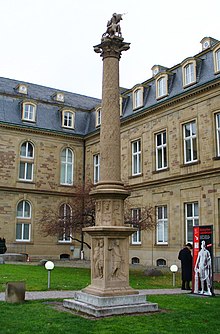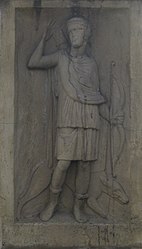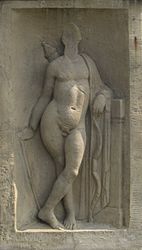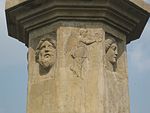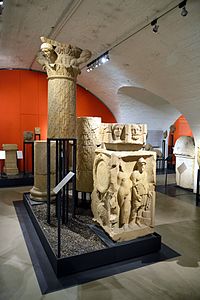Jupiter giant column from Hausen an der Zaber
| Location | Hausen on the Zaber |
| Emergence | at 200 |
| excavation | 1964 |
| Depository | Roman Lapidarium Stuttgart |
| material |
Sandstone reed painted in color |
| Total height | 735 cm |
| capital | 49 × 75 cm |
| Column shaft | 395.5 × 51.5 / 45 cm |
| Wochengötterstein | 26 × 67.5 cm |
| Viergötterstein | 117 × 67.5 cm |
The giant column of Jupiter from Hausen an der Zaber is a consecration memorial for Jupiter and Juno , which a Roman citizen had erected on his estate in Hausen an der Zaber around the year 200 . During an excavation in 1964, the almost completely preserved remains of the column were recovered and brought to the collection of the Roman Lapidarium in Stuttgart .
The monument is considered to be "one of the most beautiful, largest and most completely preserved of its kind", and "the ornamentation of the shaft in such rich design is unique". Casts of the reconstructed column were placed in Hausen, Stuttgart , Köngen and Güglingen .
Cover picture: Replica of the giant Jupiter column from Hausen an der Zaber in front of the Roman Lapidarium in Stuttgart (→ picture comment ).
description
In his monograph on the Upper Germanic Jupiter Columns , Gerhard Bauchhenß traces the "custom of the Jupiter Columns so widespread in Upper Germany and Gaul" to two roots:
- "The native, largely Celtic population brought with them the idea of a god to be worshiped in the form of a tree."
- "The Great Jupiter Column in Mainz , which stands entirely in Roman tradition, provided the impetus for translating the tree cult into stone monuments."
The seven meter high Jupiter giant column from Hausen an der Zaber follows this tradition. The column is made of reed sandstone, a variant of Keuper sandstone. An octagonal week god stone and the column shaft with the capital and the giant rider sculpture rise above a cuboid four-god stone .
Viergötterstein
The 1.17 meter high stone of the four gods with its profiled base plate is the lowest preserved part of the Jupiter giant column. The column probably stood on a substructure that was lost (a stepped substructure was added to the reconstructed columns). The profiled cover plate, which separated the Viergötterstein from the Wochengötterstein, was added in the reconstruction analogous to the base plate. The four gods stone has four reliefs on the sides in rectangular, framed niches.
|
| number | position | Gods | presentation | ||
|---|---|---|---|---|---|
| 1 | front | An eagle, the companion of Jupiter, the king of the gods, supports an oak wreath with leaves and acorns with its outstretched wings. The wreath includes a dedicatory inscription:
|
|||
| 2 | right |
Venus , goddess of love volcano , god of forge |
Naked woman with scepter, clothed man with hammer and pliers. | ||
| 3 | back | Diana , goddess of the hunt | Dressed woman with bow, quiver and hunting dog. It appears like a copy of the volcano on relief 2. | ||
| 4th | Left | Apollo , god of archers | Naked man with bow, arrow and quiver. Its feminine body seems to be borrowed from the Venus in relief 2. |
Wochengötterstein
The octagonal stone of the week was broken into four horizontal disks, of which only the two middle ones were found, which together are 26 cm high. The missing panes were added to the replica as well as the dividing plate between Viergötterstein and Wochengötterstein and the octagonal cover plate.
The weekly god stone shows a relief of the goddess of victory Victoria on the sides and in framed niches reliefs with busts of the seven weekday gods . The reliefs are, starting from Victoria, and starting with Saturday, arranged in a clockwise direction of the days of the week (see diagram).
|
|
| number | weekday | God | presentation |
|---|---|---|---|
| 1 | - | Victoria , goddess of victory | Winged female figure with a laurel wreath and palm fronds, originally probably arranged above the dedicatory inscription of the stone of the four gods. |
| 2 | Saturday | Saturn , god of sowing | Bust of a man with a full beard and a thick head of hair. |
| 3 | Sunday | Sol , sun god | Bust of a young man with a halo- like disk of the sun behind his head. |
| 4th | Monday | Luna , moon goddess | Female bust with the horns of a reclining crescent moon behind the head. |
| 5 | Tuesday | Mars , god of war | Bust of a young man with curly hair. |
| 6th | Wednesday | Mercury , god of commerce | Bust of a young man with curly hair. |
| 7th | Thursday | Jupiter , god of thunder | Bust of a man with a full beard and curly hair. |
| 8th | Friday | Venus , goddess of love | Female bust with a bunch of hair combed back. |
Column shaft
The column shaft, including the base and capital, is almost four meters high and has a diameter of 51.5 cm above the base and 45 cm below the capital. It consists of six drums, the lowest of which is made from a block with the Attic base consisting of two bulges . At a height of 83.5 cm, a 10 cm high band divides the decoration of the shaft into two unequal parts. Both shaft parts are covered like scales with stylized oak leaves, at the base of which an acorn grows out. Above the ribbon, leaves and acorns hang down, below the ribbon they point upwards. The oak jewelry is a special feature that distinguishes the Hausener column from the other well-known columns, which are decorated either with a simple scale relief, with vine tendrils or with figure reliefs. The oak decoration of the column shaft and the wreath in the consecration relief of the Viergötterstein refer to the roots of the Jupiter giant columns in the Celtic tree cult.
capital
The 49 cm high and 75 cm wide capital shares with Corinthian capitals an outer wreath of acanthus leaves . In place of the corner volutes behind the wreath of leaves emerge the shoulder busts of the four seasons, which bend down like gargoyles with their long necks and with their heads support the cover plate ( abacus ) swinging forward at the corners . The capitals ( kalathos ), which expand upwards, are decorated above the wreath of leaves by a band with framed tongues, a horizontal strip with a rotating band pattern and an egg stick .
The heads of the seasons are arranged to the left and are characterized by the headgear: the goddess of spring, summer and autumn wear wreaths of flowers, ears of wheat or fruits, and the goddess of winter wraps her head in a cloak.
|
Giant rider
The figure of the giant rider represents an allegory of the gigantomachy , the battle of the giants against Jupiter and the Olympian gods , in which Jupiter was victorious.
The fragments of the giant rider found during the excavations were: the torso of Jupiter, the head of the horse, the head of the giant with the front legs of the horse and the base plate with the lower body and hands of the giant. The fragments were sufficient for the reconstruction of the giant rider.
The thunderstorm god Jupiter blows away on his horse with a bare chest and a coat billowing in the wind, the reins in his left hand and a bundle of lightning in his right hand . The horse rears up at a gallop over a naked giant who seals on the ground on hands and snake feet.
history
Emergence
The giant column of Jupiter from Hausen an der Zaber was erected around the year 200 as a consecration memorial for Jupiter and his wife Juno, the two highest gods of the Romans. Hausen belonged to the Roman province of Upper Germany ( Germania superior ), in whose area the remains of over a hundred columns of Jupiter's giants have been found. The donor of the monument was the landowner Gaius Vettius Connougus, a Roman citizen of probably Celtic origin. By building the consecration mark on his estate, he fulfilled a vow, probably as thanks for the flourishing of his harvests.
When the Alamanni occupied the area in the years 233 to 235, they burned the manor and destroyed the found cult marks "in order to destroy the magical power that was believed to be inherent in the images of the deities" Faces of the idols mutilated.
excavation
During construction work in 1964, the remains of two giant columns of Jupiter and some smaller cult images were found in an underground depression. Almost all parts of a giant column of Jupiter were preserved, even if damaged:
- the four-god stone including base plate, without cover plate
- the two middle discs of the four discs of the weekly god stone, without cover plate
- all six column drums including base and capital
- Fragments of the giant rider
The other giant column of Jupiter was larger and artistically more valuable. However, since only the Viergötterstein, the column base and a column drum with a giant battle relief were found, no reconstruction was possible.
The finds were transferred to the State Museum in Stuttgart and included in the collection of the Roman Lapidarium . A reconstruction of the first giant column of Jupiter was set up in the hall of the lapidarium, which at that time was still housed in the fruit box on Schillerplatz . This type of arrangement enabled the visitor to view the column from all three floors.
When the lapidarium moved to a vaulted cellar on the south side of the New Palace in 1989 , the replica of the column was set up outside in front of the lapidarium entrance. As a result, the view of the upper part of the column, especially the giant rider, is only possible from a frog's perspective. However, the original fragments of the column can be viewed at eye level in the lapidarium. All parts of the well-preserved column are on display (except for the fragments of the giant rider), from the other column the stone of the four gods and the column drum with the giant fight can be seen in relief.
|
Locations
From the fragments in the Roman Lapidarium in Stuttgart, the Jupiter giant column from Hausen an der Zaber was reconstructed in its original size in 1967 and erected in Stuttgart. Replicas of the reconstruction are in Hausen an der Zaber and on a roundabout island in Köngen. In the Römermuseum Güglingen there is a scaled down colored version of the Jupiter giant column and in Welzheim a replica of the reconstructed giant rider.
| place | Location | description | map |
|---|---|---|---|
| Brackenheim - Hausen | Roman garden, Nordhausener Strasse, diagonally opposite the Jupiter wine cellar. | The column is located near the original site in the Roman Garden, which is said to be reminiscent of Roman times with the southern flair of its Mediterranean plants. - Replica of artificial stone in original size by Günter Weinreuter, 1967. Two-tier, square substructure. Giant rider with a bundle of lightning. |
|
| Güglingen | Roman Museum, Marktstrasse 18. | The column was created as a colored wooden model on a scale of 1: 3 by the model maker Wolfgang Hart, Ingersheim am Neckar, for the Great State Exhibition of Baden-Württemberg in 2005. In 2006 the model was loaned to the Roman Museum in Güglingen, where a Roman settlement was located from the 2nd to 3rd centuries. Two remains of a giant column of Jupiter, a giant rider and a column drum, are exhibited in the museum. - height 250 cm. Three-step square base. Giant rider with a bundle of lightning. |
|
| Kings | Lorchkreisel, Bahnhofstrasse 1. | The municipality of Köngen is located on the area of a Roman settlement from the year 100. The column stands in the center of the flower-adorned traffic island of the Lorchkreisel. - Replica in original size. Three-tier, round substructure with a paving stone border. Giant rider with a bundle of lightning. |
|
| Stuttgart-center | Planie, by the New Castle. | The column first stood in the fruit box, since 1989 it has stood in front of the south facade of the New Palace at the entrance to the Roman Lapidarium in Stuttgart , in which the original fragments are exhibited. - Artificial stone replica in original size by Günter Weinreuter. Two-tier, square concrete substructure. Giant riders without a bundle of lightning. |
|
| Welzheim | Rudersberger roundabout, junction Rudersberger Strasse / Friedrich-Bauer-Strasse. | The Roman era Welzheim, with its two forts on the Upper German-Raetian Limes, was an important Roman troop location. To commemorate the Roman times, an almost eight meter high, red steel column with a replica of the Jupiter giant rider in original size was erected on the Rudersberg roundabout. The column and its top served as a landmark for the large Roman exhibition "Imperium Romanum" in Stuttgart in 2005 and was moved to the Rudersberg roundabout in 2009. - Giant rider with lightning bolt. |
|
|
literature
- Gerhard Bauchhenß : The giant columns of Iupiter in the Roman province. Germania superior. In: Derselbe and Peter Noelke : The Iupiter columns in the Germanic provinces. Cologne 1981, especially pages 142–144.
- Philipp Filtzinger : Hic saxa loquuntur: Roman stone monuments in the Lapidarium Stiftsfruchtkasten and in the exhibition "The Romans in Württemberg" in the Old Castle = This is where the stones talk. Aalen 1980, pages 122-141. - With 11 black and white plates.
- Philipp Filtzinger : Jupiter giant column, Brackenheim-Hausen an der Zaber. In: Dieter Planck : The Romans in Baden-Württemberg: Roman sites and museums from Aalen to Zwiefalten. Stuttgart 2005, pages 49-50.
- Hans Klumbach : The Roman sculpture find from Hausen an der Zaber (Heilbronn district). Stuttgart 1973. - With 34 black and white plates and a 1:10 scale elevation.
- Hans Klumbach : The giant columns of Jupiter from Hausen an der Zaber: Lapidarium; Stiftsfruchtkasten Schillerplatz. Stuttgart [around 1974]. - With a 1:10 scale elevation.
- Gerd body skirt; Karin Mader: Art in the district, Baden-Württemberg, Volume 2. Boeblingen district, Esslingen district, city of Stuttgart. Stuttgart 2009, pages 54-55, online . - Replica of the giant column of Jupiter on the Lorchkreisel in Köngen.
- Gerd body skirt; Karin Mader: Art in the district, Baden-Württemberg, Volume 3. Ludwigsburg district, Rems-Murr district. Stuttgart 2009, pages 86-87, online . - Replica of the Jupiter giant rider on the Rudersberg roundabout in Welzheim,
Web links
Footnotes
- ↑ #Filtzinger 1980 , page 122
- ↑ height × width.
- ↑ height × width. Height: including base and capital. Width: greatest width above the base / smallest width below the capital.
- ↑ Height of the fragments preserved × width.
- ↑ height × width.
- ↑ #Klumbach 1974 .
- ↑ #Klumbach 1973 , page 30.
- ↑ # Bauchhenß 1981 , page 41.
- ↑ #Klumbach 1973 , pages 12-14, #Filtzinger 1980 , pages 122-123.
- ↑ #Klumbach 1973 , pages 14-15, #Filtzinger 1980 , page 123rd
- ↑ #Klumbach 1973 , page 15, #Filtzinger 1980 , page 123rd
- ↑ This type of capitals is therefore referred to as head or bust capital.
- ↑ #Klumbach 1973 , pages 15-16, #Filtzinger 1980 , pages 123-124.
- ↑ #Klumbach 1973 , page 16-17, #Filtzinger 1980 , page 124th
- ↑ # Bauchhenß 1981 , page 3.
- ↑ #Klumbach 1974 .
- ↑ #Klumbach 1973 , page 10.
- ↑ #Klumbach 1973 , page 9-11, #Filtzinger 1980 , page 124th
- ↑ #Filtzinger 1980 , page 130, Fig. H 12.
- ↑ Roman Lapidary .
- ↑ Modellbau Wolfgang Hart , "Imperium Romanum".
- ↑ #Leibrock 2009.2 .
- ↑ #Leibrock 2009.3 .
